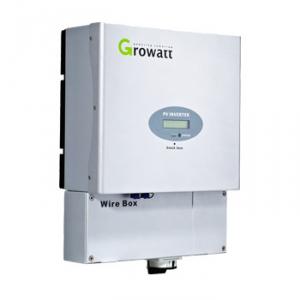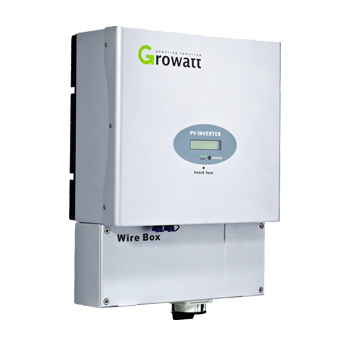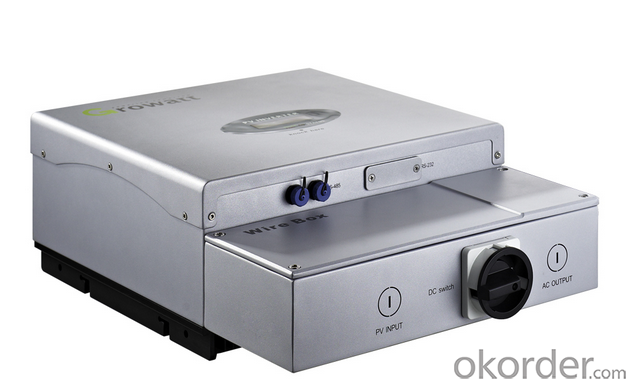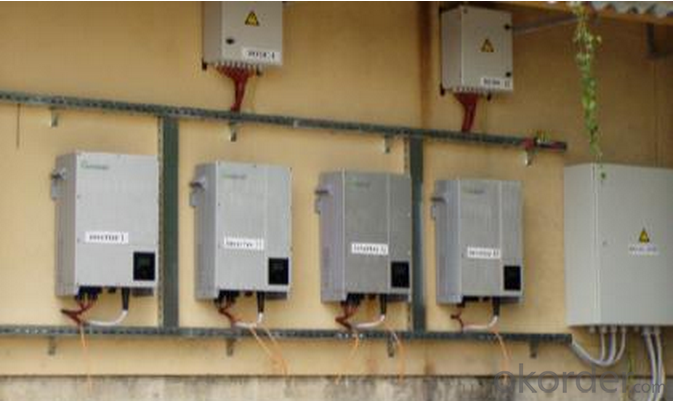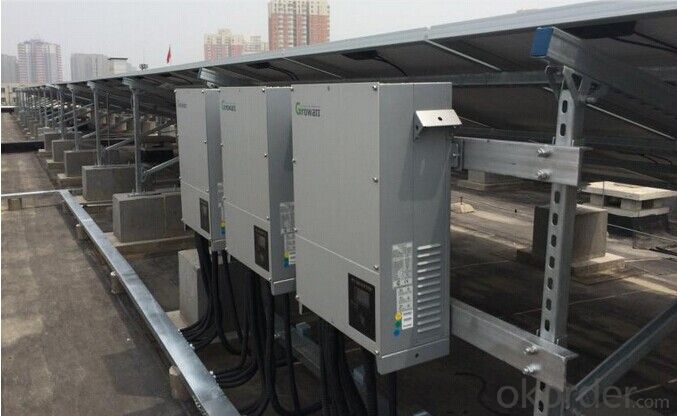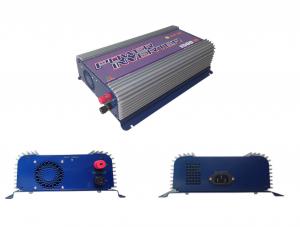Schuco Solar Inverter 1500w Solar Grid Tie Inverter Transformerless 1.5kw String Inverter ETL/FCA
- Loading Port:
- Shekou
- Payment Terms:
- TT or LC
- Min Order Qty:
- 10 pc
- Supply Capability:
- 100000 pc/month
OKorder Service Pledge
OKorder Financial Service
You Might Also Like
1500w solar grid tie inverter transformerless 1.5kw string inverter ETL/FCA
Solar inverter 1500TL-3000TL-US
Maximum efficiency of 97.5% and wide input voltage range
Internal DC Switch
Transformerless GT topology
Compact design
Bluetooth/ RF technology/ Zigbee/ Wi-Fi
Sound control
Easy installation
General Descriptions
Leading-Edge Technology, CE,TUV ,VDE , SAA,DK5940 Certicificates.
> Maximum efficiency of 97.8 % and wide input voltage range
> Internal DC STWTICH
> Transformerless H6 topology
> Compact Design
> MPPT control
> MTL-String
> RS485 RS432 bluetooth Technology
> Comprehensive Growatt warranty program
> Easy country configuration, easy installation
> Multi-language display
Communications
> RS485 /GPRS interfaces
> Computer monitoring software
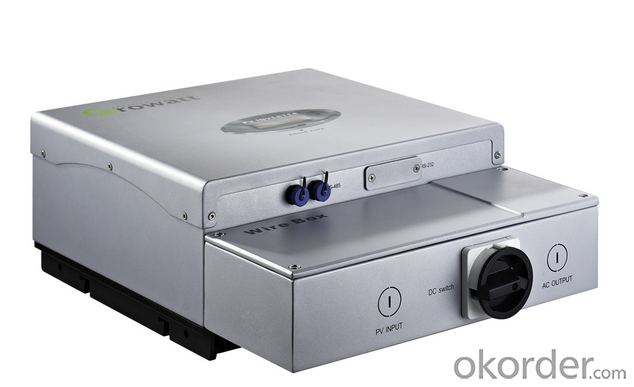
1500-US | 2000-US | 3000-US | |
| Inputdata | |||
Max.DCpower | 1800W | 2300W | 3200W |
Max. DC voltage | 450V | 500V | 500V |
Start Voltage | 150V | 150V | 150V |
PV voltage range | 100V-450V | 100V-500V | 100V-500V |
MPP voltage range(full load) | 120V-400V | 120V-450V | 120V-450V |
Max. input current of per MPP tracker | 12A | 14A | 17A |
Number of independent MPP | 1/1 | 1/2 | 1/2 |
Rated AC output power | 1500W@208Vac | 1800W@208Vac | 2500W@208Vac |
AC nominal voltage; range | Default:240V single phase, optional:208 single phase;183-228@208V,211-264V@240V | ||
Max. output current | 8A/7.8A | 9.7A/9.4A | 15A/14.2A |
AC grid frequency; range | 60Hz; 59.3-60.5Hz | 60Hz; 59.3-60.5Hz | 60Hz; 59.3-60.5Hz |
Power factor | 1 | 1 | 1 |
THDI | <3% | <3% | <3% |
Grid connection type | Single phase | Single phase | Single phase |
| Efficiency | |||
Max.efficiency | 97% | 97% | 97% |
| Protection Devices | |||
DC reverse polarity protection | yes | yes | yes |
DC switch rating for each MPPT | yes | yes | yes |
Output over current protection | yes | yes | yes |
Output over voltage | yes | yes | yes |
Ground fault monitoring | yes | yes | yes |
Grid monitoring | yes | yes | yes |
Integrated all-pole sensitive | yes | yes | yes |
| Generaldata | |||
Dimensions(W/H/D) in mm | 360/465/165 | 360/465/165 15.1KG | 360/465/165 |
| Features | |||
DC connection AC connection Display | Screw terminal Screw terminal LCD opt/opt/opt | Screw terminal Screw terminal LCD yes/yes/ opt/opt/opt | Screw terminal Screw terminal LCD yes/yes/ opt/opt/opt yes/opt |
| Certificates and Approvals UL1741, UL1998, IEEE 1547, CSA C22.2 No.107.1-1, FCC Part15(Class A&B) |
FAQ
1. Have any design tool and how to use it?
Shine Design is the system design software just for inverters, It can conduct installers to figure out panel numbers for a system, panel numbers for each string, and which inverter model is suitable for the system. Moreover, it can print a design report after input all necessary parameters, can calculate DC/AC wire wastage, annual generation, etc.
2. Does the inverter have monitoring solutions for residential system?
For small rating system, we have wired two monitoring solution (ShineNet via RS232 or RS485). (a) Local wireless monitoring solution (ShineVision via RF module communication) (b) Global wireless monitoring solution (WIFI module via WIFI network)
3. Do you have free solution for monitoring?
ShineNet is an inverter monitoring software run in Windows XP, Windows Vista, Windows 7 operating system. It can monitor inverter via RS232 (or RS232 convert to USB cable) and RS485 wire connection. Customers can purchase the cable locally to get the inverter monitored, it is simple.
- Q: How does MPPT technology work in solar inverters?
- MPPT (Maximum Power Point Tracking) technology in solar inverters works by constantly monitoring the voltage and current of the solar panels and adjusting the resistance to ensure the panels are operating at their maximum power point. This optimization allows for maximum energy production from the solar panels, even in varying weather conditions and shading.
- Q: What is the role of a surge protector in a solar inverter?
- The role of a surge protector in a solar inverter is to protect the inverter and other connected devices from power surges or voltage spikes that can occur in the electrical system. It helps to regulate and stabilize the incoming electricity, preventing damage to the inverter and ensuring the smooth and efficient operation of the solar power system.
- Q: Can a solar inverter work without batteries?
- Yes, a solar inverter can work without batteries. In a grid-tied solar system, the inverter converts the DC power generated by the solar panels into AC power, which can be used to power appliances or fed back into the utility grid. Batteries are typically used in off-grid systems to store excess energy for later use, but they are not necessary for the basic function of a solar inverter.
- Q: How do you connect solar panels to a solar inverter?
- To connect solar panels to a solar inverter, you need to follow these steps: 1. Locate the positive (+) and negative (-) terminals on the solar panels. 2. Connect the positive terminal of the first solar panel to the positive terminal of the second panel using a solar PV cable or connector. Repeat this process for other panels if necessary. 3. Connect the negative terminal of the first panel to the negative terminal of the second panel using the same method as above. 4. Once all panels are connected in series or parallel, connect the positive terminal of the last panel to the positive terminal of the solar inverter. 5. Finally, connect the negative terminal of the last panel to the negative terminal of the solar inverter. It's important to ensure that the connections are secure and tightened properly to prevent any loose connections. Following the manufacturer's instructions and consulting a professional electrician or solar installer is recommended for a safe and efficient installation.
- Q: What is the role of a transformer in a solar inverter?
- The role of a transformer in a solar inverter is to convert the direct current (DC) electricity generated by the solar panels into alternating current (AC) electricity suitable for use in homes and businesses. The transformer helps to step up or step down the voltage levels, ensuring efficient and safe transmission of electricity from the solar panels to the electrical grid or connected loads.
- Q: Can a solar inverter be connected to a smart home or monitoring system?
- Yes, a solar inverter can be connected to a smart home or monitoring system. Many modern solar inverters have built-in communication capabilities, such as Wi-Fi or Ethernet connectivity, which allows them to connect to a smart home or monitoring system. This enables users to monitor and control their solar power generation and energy consumption remotely, receive real-time data and alerts, and optimize their energy usage for maximum efficiency.
- Q: How does a solar inverter handle voltage regulation during sudden load changes?
- A solar inverter handles voltage regulation during sudden load changes by continuously monitoring the grid frequency and voltage. When there is a sudden load change, the inverter adjusts its power output accordingly to maintain a stable voltage level. It does this by dynamically controlling the power conversion process, regulating the flow of electricity from the solar panels to the grid. This ensures that the voltage remains within the acceptable range even during sudden changes in load demand.
- Q: Can a solar inverter work during a power outage?
- No, a solar inverter cannot work during a power outage unless it is specifically designed with a battery backup system.
- Q: What is the maximum DC input current that a solar inverter can handle?
- The maximum DC input current that a solar inverter can handle varies depending on the specific model and capacity of the inverter. It is typically mentioned in the product specifications and can range from a few amps to several hundred amps.
- Q: Can a solar inverter be used in remote locations?
- Yes, a solar inverter can be used in remote locations. Solar inverters are designed to convert the DC power generated by solar panels into AC power that can be used to power electrical devices. They can be used in off-grid or remote locations where access to a traditional power grid is not available.
Send your message to us
Schuco Solar Inverter 1500w Solar Grid Tie Inverter Transformerless 1.5kw String Inverter ETL/FCA
- Loading Port:
- Shekou
- Payment Terms:
- TT or LC
- Min Order Qty:
- 10 pc
- Supply Capability:
- 100000 pc/month
OKorder Service Pledge
OKorder Financial Service
Similar products
Hot products
Hot Searches
Related keywords
